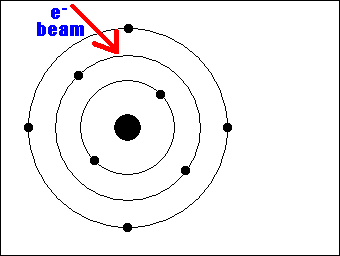
| Auger spectroscopy measures the energy of electrons from the Auger effect of excited electrons in the surface region. There are two different ways that an atom with an excited core electron (a core electron hole) can return to its ground state. The first is that an energetically higher electron “jumps” to the hole left by the excited core electron, thereby releasing characteristic x-ray radiation. The second is the Auger effect, by which the hole left by the excited core electron is filled by an outer electron. The energy from this is transferred by a radiationless process to another electron that will then be ejected from the surface with a characteristic kinetic energy. The result is a spectrum of the intensity of electrons as a function of the kinetic energy of the Auger electron with the placement of the peaks giving a qualitative view of what elements are present on the surface. |  |
Temperature-programmed desorption is the process in which an adsorbed species is heated to a specified temperature, resulting in certain reactions and the desorption of their products from the surface. A mass spectrometer then measures the concentration of each of the products. Analysis of desorption temperatures and of the corresponding desorbed products can yield information about the chemical kinetics of the reactions that are being observed.
High-resolution electron energy loss spectroscopy (HREELS) is one of the most advanced instruments which is mainly used to obtain the vibrational signature of surface and adsorbate species under ultrahigh vacuum conditions. By assigning the vibrational modes of the collected spectrum, the chemical bonding between surface and adsorbate, binding geometry and molecular orientation and ordering can be identified. This method is widely employed in various surface science researches. In the Bernasek Lab, we use it to identify the growth and chemical bonding of molecular architectures on semiconductor surfaces and the mechanisms of catalytic reactions on metal and alloy crystal surfaces.
The spectrometer in our HREELS/UHV system can offer a resolution up to 4 cm-1 for the direct beam, which is close to IR resolution. Compared to IR used in vacuum surface science, HREELS has a higher surface sensitivity and wider energy window of vibration from 100-8000 cm-1. In addition, our HREELS can also be used for exploring electronic transitions of surfaces or adsorbates, with an incidence energy of 15-20 eV. In this case the method is called electronic EELS. It can even offer valence band information about the surface and adsorbate, similar to UPS.
The basic principle of HREELS is to use an electron monochromator to give a well-defined electron beam of a fixed incident energy which scatters from the surface. The scattered electrons are then analyzed using an appropriate electron energy analyzer. The inelastically scattered electrons lose a certain amount of energy. The magnitude of the energy loss Edelta=Eo-E is equal to the vibrational quantum (i.e. the energy) of the vibrational mode of the surface or adsorbate excited in the inelastic scattering process.
There are two inelastic excitation mechanisms of the surface vibrational modes, the dipole scattering mechanism and the impact scattering mechanism. The dipole scattering mechanism occurs through an interaction mediated via long range electric fields set up in both the vacuum and the sample by the probing electron and by the surface excitation. Because the dipole interaction is valid in a range much greater than atomic dimensions, it can be described classically. The dipole scattering mode of HREELS is carried out in a specular geometry, where the electron incidence angle (60o to the normal of sample surface) is equal to the electron scattering angle. At this specular geometry, the contribution of the dipole scattering mode dominates the vibrational excitation because the cross section for dipole scattering is a few hundred times larger than that for impact scattering. Thus, we generally obtain surface vibrational information from the dipole scattering mode in a specular geometry. Impact scattering is the direct scattering of electrons from surface atoms. Thus, the electron scattering and vibrational excitation occurs over a wide range of angles. A full description of impact scattering events needs a complex quantum mechanical description of the interaction between low energy electrons and the surface atoms. The impact scattering will play an important role when molecular orientation or binding geometry is to be identified. Because all vibrational modes can be excited by impact scattering over a wide range of angles, this excitation does not depend on the direction of the incident electron beam. However, the excitation of vibrational modes by dipole scattering strongly depends on the direction of the incident electron beam. Thus, by changing the direction of the incident electron beam, the excitation of vibrational modes by dipole scattering will be significantly weaker but that by impact scattering remains at the same level. This examination method is called the off-specular geometry. Comparing the spectra of the specular geometry and off-specular geometry, the molecular orientation and binding geometry for adsorbates can be determined.